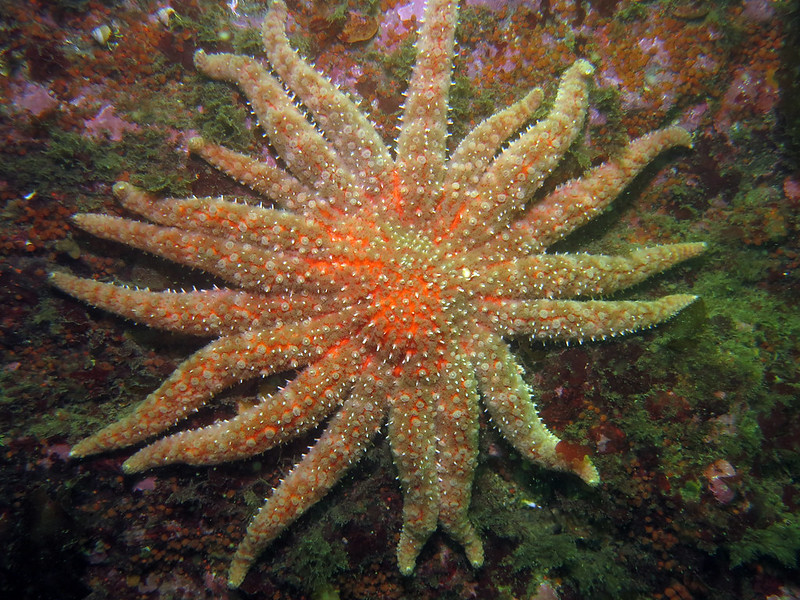
Sea Wonder: Sunflower Sea Star

Photo credit: Gullekson/WDFW
Description
The sunflower sea star (Pycnopodia helianthoides) is named for its radial arms that resemble the yellow petals of sunflowers you might find in someone’s garden. The sunflower sea star is the largest species of sea star in the global ocean, with 24 large arms and a diameter of nearly three feet from arm tip to arm tip when full grown. They can grow to weigh as much 13 pounds and, despite its large size, this species may also be the world’s fastest sea star. Like other sea stars, the sunflower sea star can regenerate damaged or missing arms, and can essentially clone themselves if a detached arm has a portion of the animal’s central disk attached to it.
The sunflower sea star is a colorful creature, with skin that can be purple, orange, brown, or yellow. It has white spines all over its body and tube feet that cover each of its 24 arms to help the sea star move along the ocean floor. The tube feet also help the sea star to grip onto rocks, other surfaces, and prey when needed.
The sunflower sea star has a unique skeleton that is made up of disjointed pieces, which allows the sea star to be very flexible and to move quickly. Most sea stars have a single, fixed skeleton. The sunflower sea star’s stomach is found on its ventral or underside near the center of its body, also known as the oral surface. This positioning allows the animal to enlarge its body and open its mouth wide to take in large prey.
Diet and Habitat
The sunflower sea star is a voracious carnivore. It eats sea urchins, crabs, snails, chitons, dead or dying squid, and other sea stars. Sea urchins comprise between 21 and 98 percent of a sunflower sea star’s diet, and a sea star can eat as many as five sea urchins in a week. To find vulnerable prey, sunflower sea stars use their strong sense of smell and very sensitive light receptors to distinguish between light and dark areas. They are speedy and can extend their eight leading arms out in front of them to grab onto any prey trying to escape them. Once captured, the sea star opens its mouth wide, protrudes its entire stomach to cover and digest their prey, and draws it back inside its body to finish the job.
The sunflower sea star can live in a variety of habitats, including rocky reefs, kelp forests, and sand flats. It is typically found in shallower waters, but it can be found as deep as 1,427 feet. Its range spans from the Aleutian Islands in Alaska down to Baja California, Mexico, though it is uncommon to find these animals south of Monterey Bay. Throughout the National Marine Sanctuary System, sunflower sea stars can be found in or near Olympic Coast, Greater Farallones, Cordell Bank, Monterey Bay, and Channel Islands national marine sanctuaries. This species is not a migratory one, but instead travels within a fairly fixed area.
Life History
Sunflower sea stars are generally solitary creatures but will often live near other individuals or aggregate in larger groups in areas where food is abundant. To reproduce, sunflower sea stars use a reproductive strategy called broadcast spawning, similar to that of some fish and coral species. Mating season occurs between March and July, with peak season taking place between mid-May and late-June. To mate, groups of sunflower sea stars gather and release gametes into the water column, with fertilization taking place at random when sperm cells and egg cells collide. The fertilized eggs develop into bilateral swimming larvae, living in its planktonic form and feeding on smaller zooplankton for up to 10 weeks. After reaching a size and developing control over their movements, larger larvae settle onto the ocean floor and metamorphosize into juvenile sea stars with a mere five arms. As they mature, they grow new arms. Individuals reach adulthood when they reach their full individual body size, which is determined by genetics, at about two years old. The average lifespan of a sunflower sea star is between 5 and 7.5 years, but some individuals have lived to be as old as about 65 years old!
Threats and Conservation
The sunflower sea star is listed as critically endangered on the IUCN Red List of Threatened Species and is classified as threatened under the U.S. Endangered Species Act. The species may be formally listed as endangered in the next year, which would make the species the first sea star to be added to the U.S. Endangered Species List.
The primary threat to the species is sea star wasting disease, a degenerative disease that has been linked to the effects of climate change. From 2013 to 2017, sea star wasting disease killed more than 90 of sunflower sea star populations in what experts have described as the largest marine disease outbreak ever recorded. This lethal event was thought to be made worse by warming ocean waters in the Pacific. The steep decline in the sunflower sea star’s population appears to be part of a cascade of ecological disruptions in California’s kelp forests and have led to imbalanced ecosystems that have yet to fully rebound. Specifically, sunflower sea stars’ reduction in numbers allowed sea urchin populations to grow unchecked, which in turn led to overgrazing of kelp and die-offs in some kelp forests. Ongoing breeding and reintroduction efforts have been underway to rebuild sunflower sea star populations along the west coast of North America, which scientists believe could help restore kelp forests and rebalance these important ecosystems.

Photo credit: Claire Fackler
